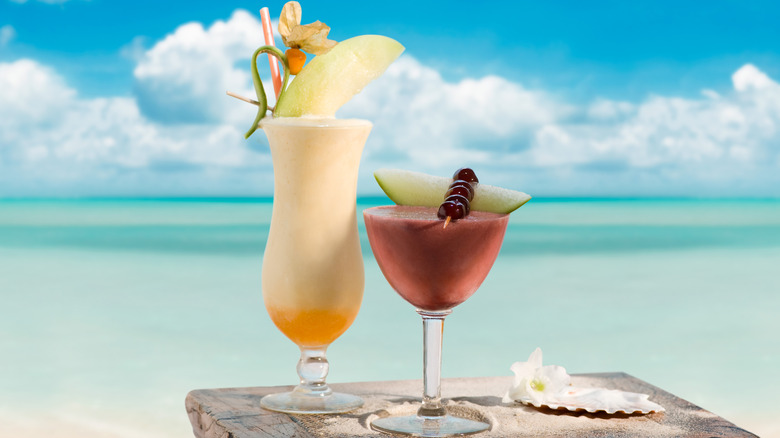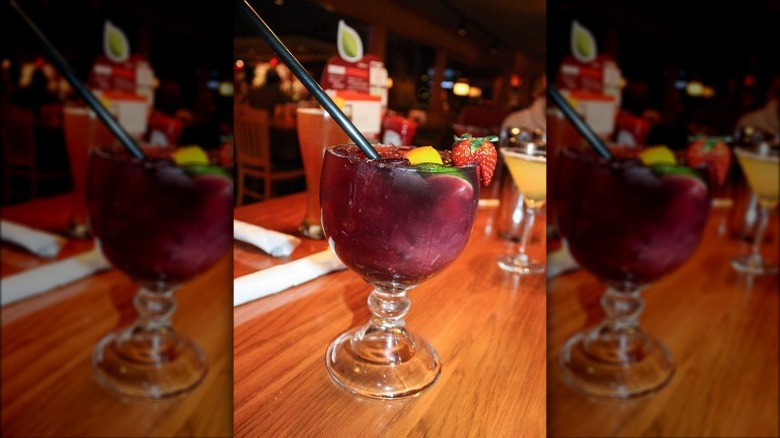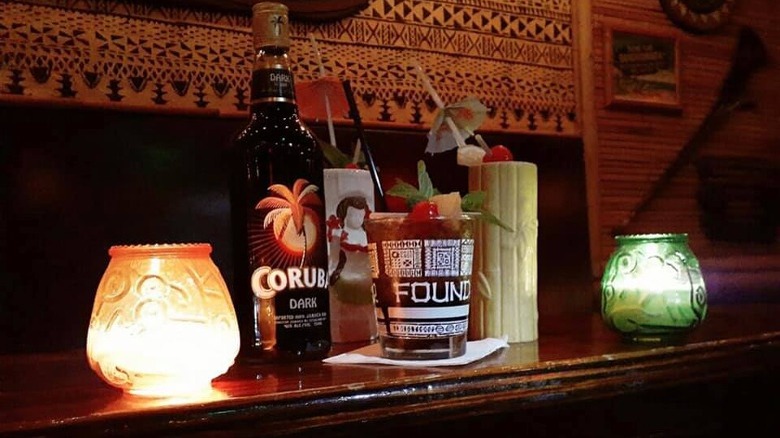Tropical Vs Tiki Drinks: Is There Actually Any Difference?
If you're asked to name a tiki drink and the first thing that comes to mind is the piña colada, bzzz, wrong, no paper umbrella for you. This drink hails from the Caribbean island of Puerto Rico and is a pretty typical tropical drink. Also known as beach drinks or boat drinks, tropical-style cocktails are often sweet, fruity, and garnished within an inch of their lives with the aforementioned umbrellas as well as pineapple chunks, maraschino cherries, lime wheels, and anything else that can fit on a glass rim.
The history of tiki drinks begins with a tropical island fantasy, too. However, this one was a dream of the South Seas as propagated by legendary California cocktail lounges Don the Beachcomber and Trader Vic's as well as numerous knockoffs. Tiki drinks, at their heart, belong to the Pacific Islands. This is despite the fact that many do contain rum, which is a product of the Caribbean. The essential difference between tropical drinks and tiki drinks, however, isn't so much their geographic inspiration as their composition.
Tropical drinks can be sweet and simple
In contrast with their tiki counterparts, tropical drinks can be rather simple. They often consist of a single spirit (which may not necessarily be rum) with one or two mixers. The aforementioned example of the piña colada is made with rum, pineapple juice, and coconut cream. The Chi Chi is the same thing made with vodka. The mojito contains rum and seltzer flavored with sugar, mint, and lime. The Cuba Libre (whose name may be traced to the Spanish-American war) is even more minimalist: It's rum and coke with a wedge of lime.
Another way these drinks stand out has to do with how they're presented. Some tropical-themed bars may strive to capture a slice of Caribbean culture and offer drinks flavored with fruits such as tamarind and guanabana. Others may be more into a Jimmy Buffett beach bum aesthetic (even if his signature drink was the margarita, which comes from Mexico and is therefore not really tropical). Tropical drinks also tend to be a staple at chain restaurants such as Applebee's and Red Lobster.
Tiki drinks have a totally different vibe
Tiki drinks are often complicated concoctions calling for multiple types of liquor and non-standard bar ingredients such as the nut-based syrup orgeat or the equally nutty but spicier falernum. Tropical drinks are great if you want something light, sweet, and fruity, but they're quite different from tiki cocktails like The Fog Cutter (made with rum, cognac, gin, sherry, orange juice, lemon juice, and orgeat) or the Singapore Sling (gin, cherry Heering, Benedictine, triple sec, pineapple juice, lime juice, grenadine, and bitters). These are what you might choose when you're in the mood for something with a complex blend of flavors that packs a serious punch.
The native habitat of the tiki drink isn't happy hour in the suburbs or even a swim-up bar in Dubai. Instead, it's the dimly-lit tiki bar complete with fish nets, carved coconuts, and barware shaped like mermaids, pineapples, skulls, and tiki gods. These faux-Polynesian lounges evolved during the Depression era as armchair escapism, but after World War II they became even more popular, possibly in part because many members of the military had spent time in the South Pacific. Although tiki bars fell out of favor during the latter part of the 20th century, the new millennium (and the TV show "Mad Men") ushered in a tiki revival. Tiki 2.0, however, is attempting to shed the old colonialist trappings, with a diverse group of mixologists promoting a more inclusive version of the tropical island fantasy.


